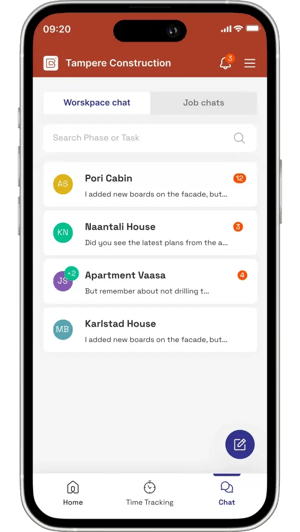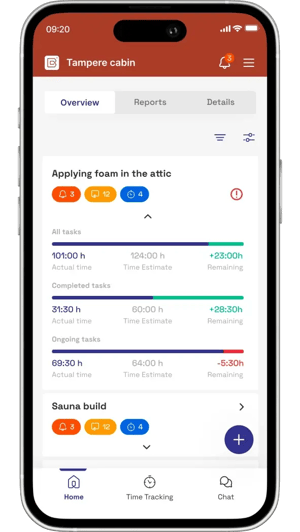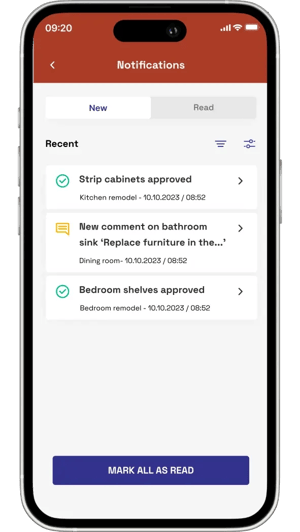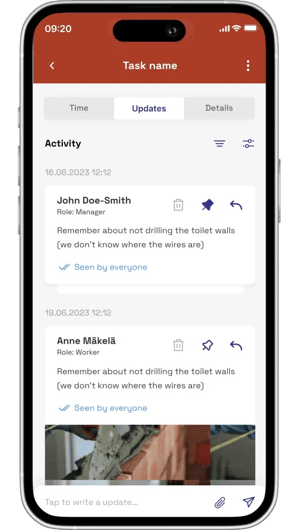Collaborate effectively
Buildbite pros
- User friendly
- Fast and easy onboarding
- Mobile-first
- Real-time data
- Affordable and transparent pricing
Buildbite limitations
- Buildbite focuses on small and medium-sized businesses. It is not intended for large enterprises managing projects in the $500 million to $1 billion range.
Buildbite pricing
Buildbite has three pricing plans (with no hidden fees):
- Basic: Ideal for small construction companies, the Basic plan $90 per month with a maximum of 5 team members or subcontractors per project.
- Standard: Meant for larger projects, the Standard plan is $150 per month for up to 20 team members or subcontractors per month.
- Premium: Large and enterprise organizations benefit from a premium plan at $205 per month for up to 50 team members or subcontractors.
2. Buildertrend - Best for construction companies seeking sales management features
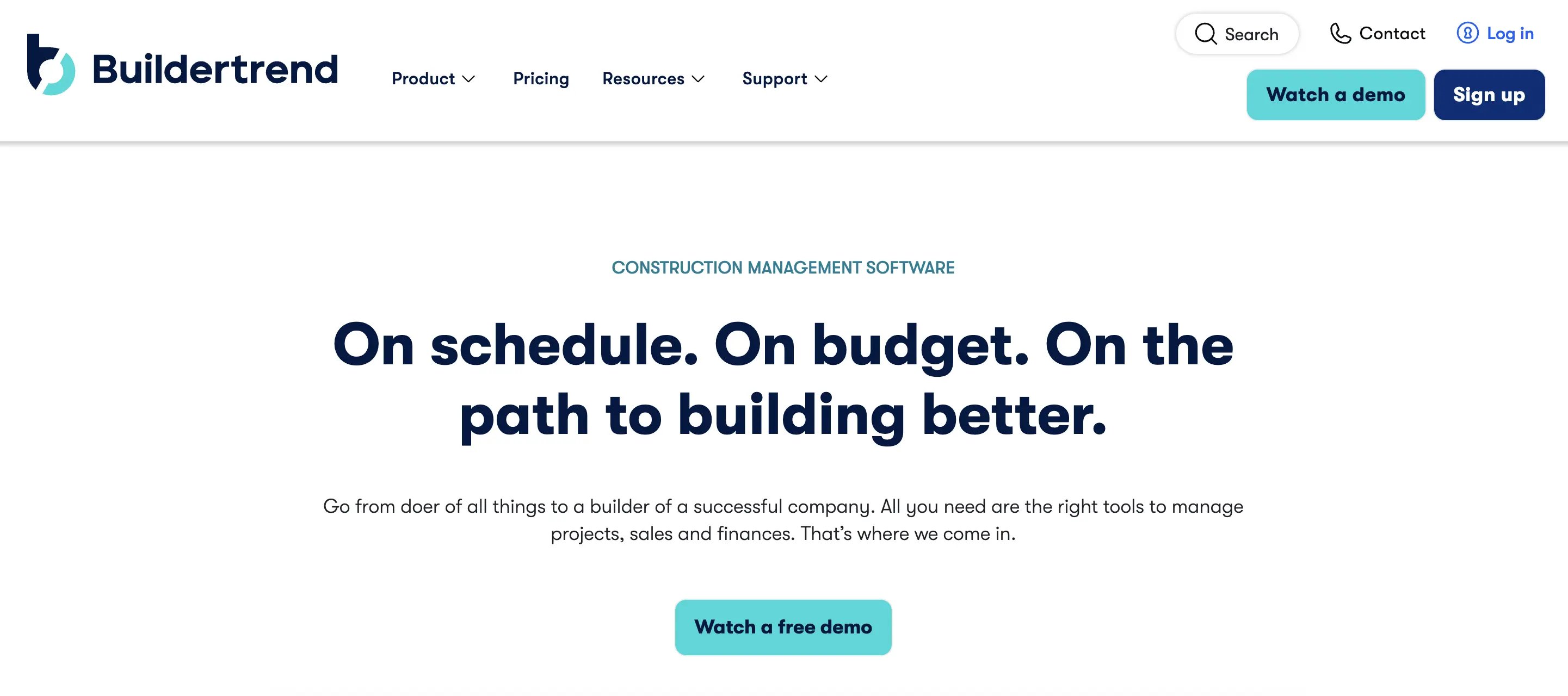
Buildertrend is a construction management software for residential property developers. If you’re a home builder, remodeler, and specialty contractor, Buildertrend helps you simplify project planning, scheduling, budgeting, and collaboration.
A key feature is its powerful sales management tool, which includes a CRM hub for tracking leads, on-the-spot contract drafting with electronic signatures, and automated email campaigns to keep your leads engaged throughout the sales cycle.
Buildertrend key features
- Sales and lead management: Manage sales and lead workflows in addition to construction processes.
- Project management: Track workflow progress and manage tasks in the app.
- Messaging and communication: Communicate in the app with live chat and messages and provide a customer portal.
- Mobile app: Users can access the app on mobile devices.
Buildertrend pros
- User-friendly interface
- Wide range of features
- Mobile app
- Unlimited users
Buildertrend limitations
- Steep learning curve due to numerous features
- Few dedicated in-field features
- Potentially high cost compared to competitors (depends on the number of your users)
Buildertrend pricing
There are three plans: Essential at $499/month, Advanced at $799/month, and Complete at $1099/month. All plans qualify for a first-month discount.
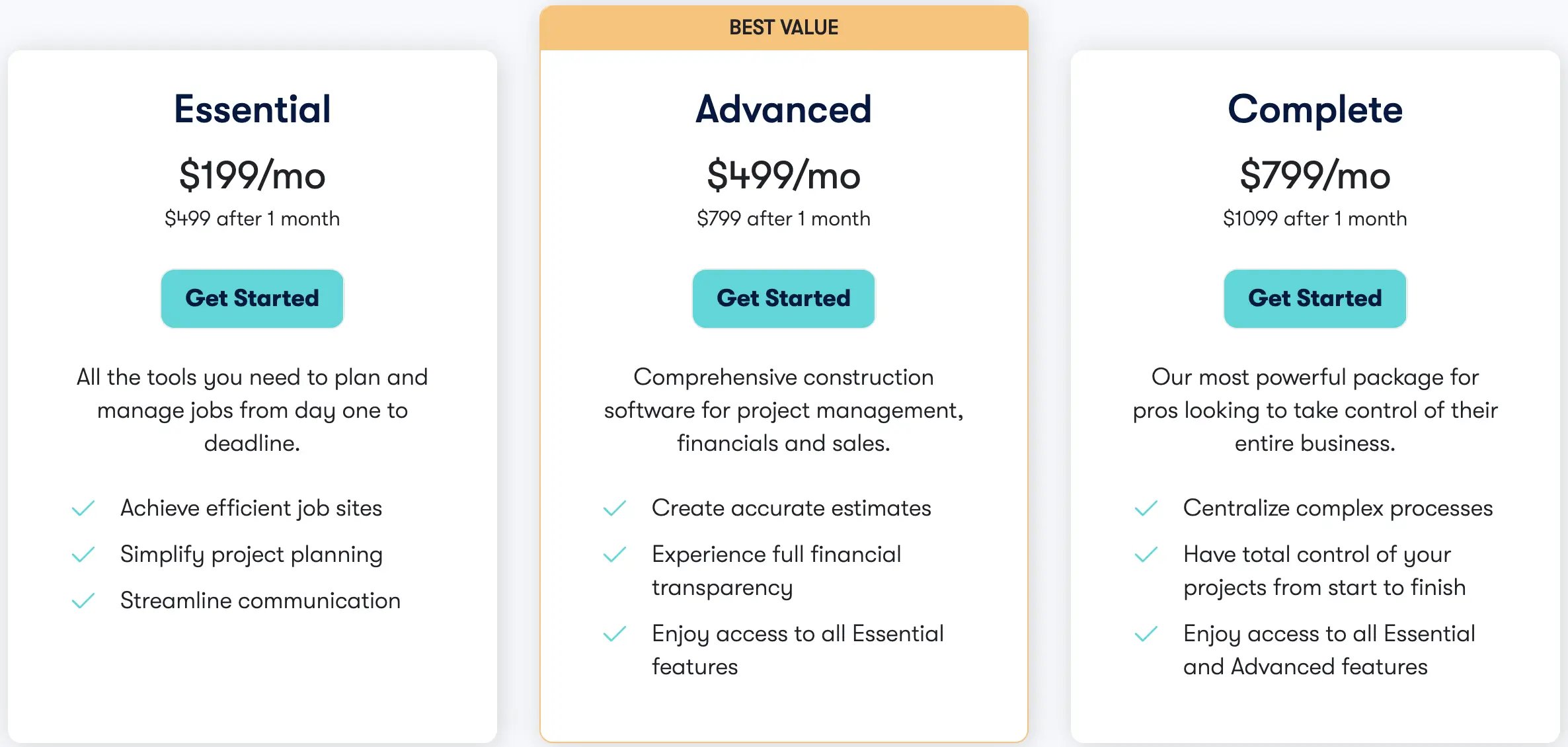
3. Admicom - Best for managing the construction lifecycle
Admicom helps large construction companies manage the entire construction process, from project estimation and documentation to project monitoring and employee training. A standout feature is its cost and quantity management tool, which allows companies to easily track expenses and identify areas for potential savings.
Admicom key features:
- Quantity calculation
- Project and order management
- Allocation of purchases and invoicing
- Sales invoicing
- Time tracking
- Inventory management
- Resource management and planning
- Electronic waybills/consignment notes
Admicom Flex pros
- Easy to use app in the field that you can learn to use in five minutes.
- Shorten time-to-money by monitoring orders in real-time and invoicing
- Robust financial management integration
Admicom limitations
- Most user reviews suggest the app can be ineffective due to bugs, but they are outdated reviews.
- No transparent pricing.
Admicom pricing
Pricing unavailable on their website
4. Fieldwire - Best for job site monitoring
-webp.webp?width=2320&height=1100&name=fieldwire%20homepage%20(1)-webp.webp)
Fieldwire is an all-in-one jobsite management solution designed to seamlessly connect the field with the office, from foreman to project managers and everyone in between. This jobsite management software is trusted on over 1,000,000 projects worldwide, to access and share information, plan and manage work, and track/report progress. That way, it enhances team coordination and significantly boosts productivity, allowing users to save up to one hour per day on more valuable tasks.
Fieldwire key features:
- Task Management
- Scheduling
- Snag List & Inspection
- RFIs & Submittals
- Change Orders
- Document Management
- Specifications & Plan Viewing
- BIM Viewer
- As-Built Drawings
- Reporting & Form Digitization
Fieldwire pros:
- User-friendly interface that’s quick to set up
- Comprehensive feature set for end-to-end project tracking
- Facilitates seamless communication across teams
- Highly effective for managing large-scale projects
Fieldwire limitations:
- Pricing can become steep, especially for small teams managing just a few projects
- Some users report clunkiness in document and drawing management
Fieldwire pricing:
Fieldwire offers per-user pricing based on additional functionality per tier, ranging from $39 to $79 per user per month.
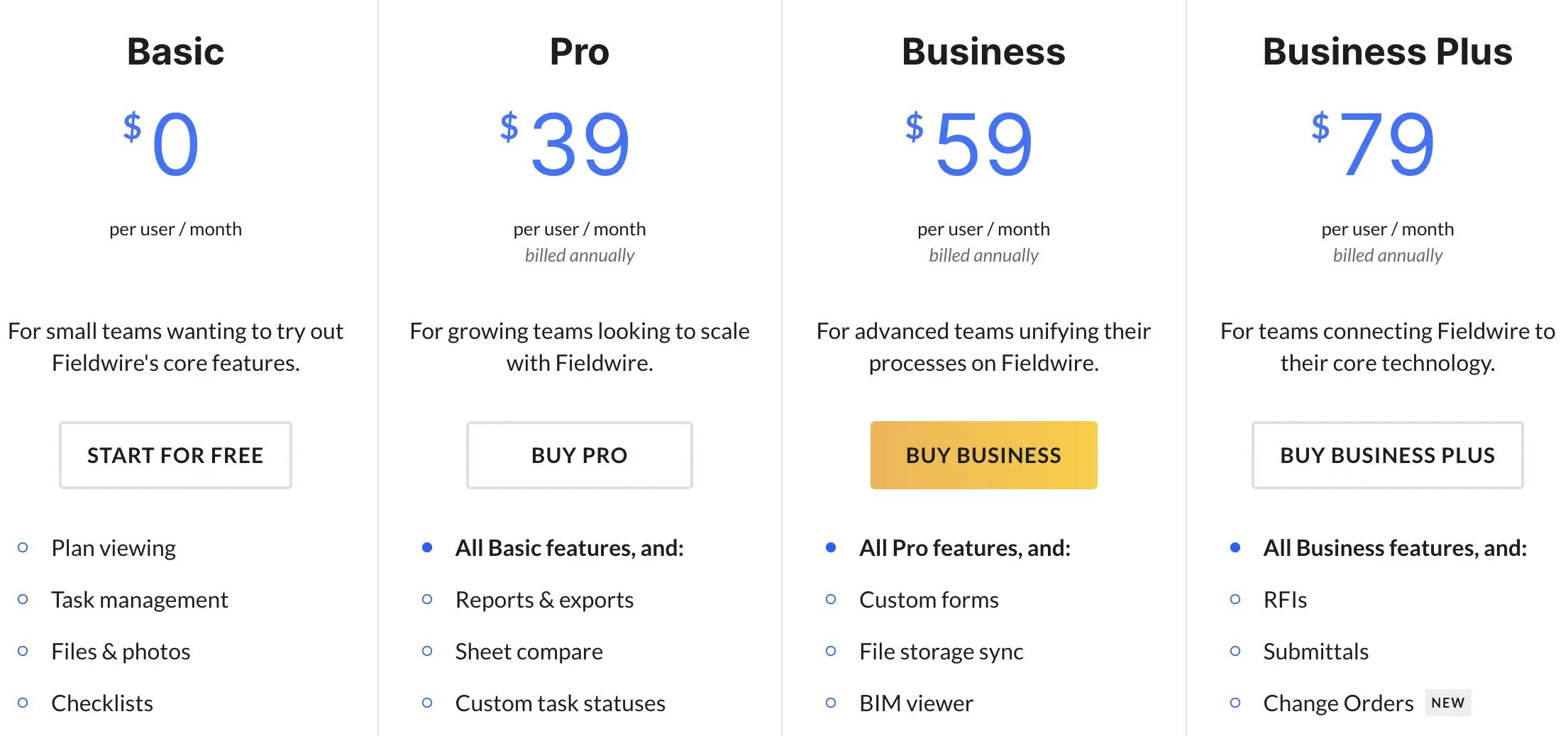
5. Procore - Best for corporate construction companies managing large commercial projects
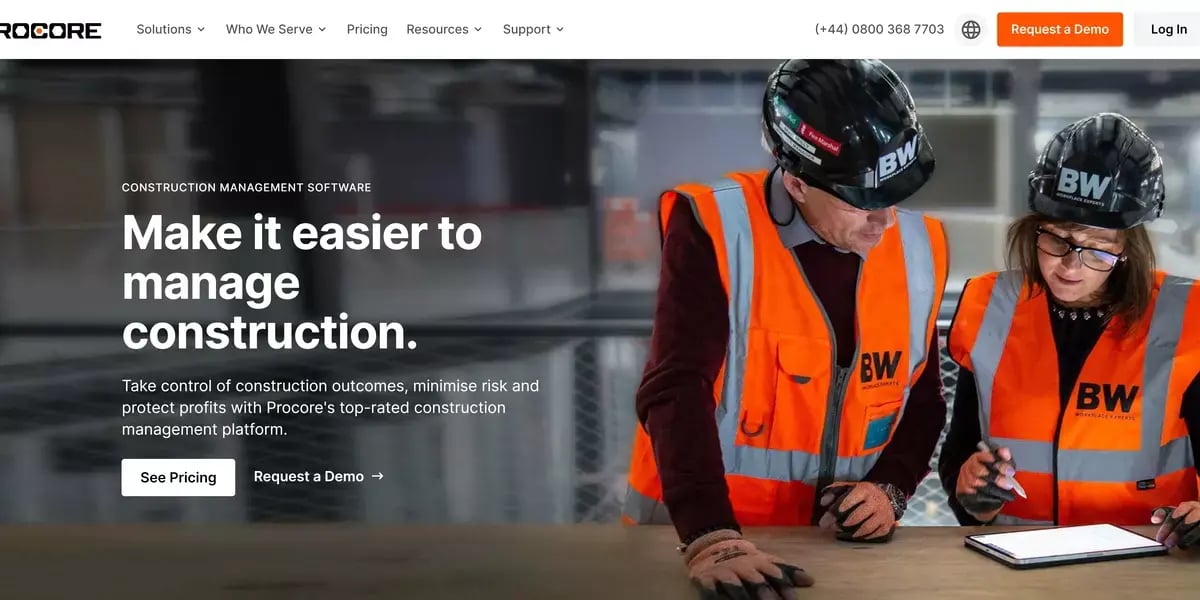
If you need to manage construction projects with a scope larger than residential buildings and small commercial properties, think commercial complexes, infrastructure projects (e.g., bridges, highways), or large residential developments– Procore might be the best choice for you.
It is a powerful construction management solution with features that account for the scale, resources involved in managing complex construction projects and planning future developments.
Procore key features:
- Preconstruction management
- Project management
- Workforce management
- Financial management
- Construction intelligence/data
Procore pros
- Strong integration capabilities
- Great customer service
Procore limitations
- Extensive onboarding process and users report a steep learning curve
- Free trial limited to certain features (such as estimating)
- It can be expensive (ranging from $4,500 to $6,588 annually)
Procore pricing
Procore’s pricing is not visible on the page. Based on this review it starts at $375 per month:

6. Letsbuild - Best for large-scale facility management teams and companies
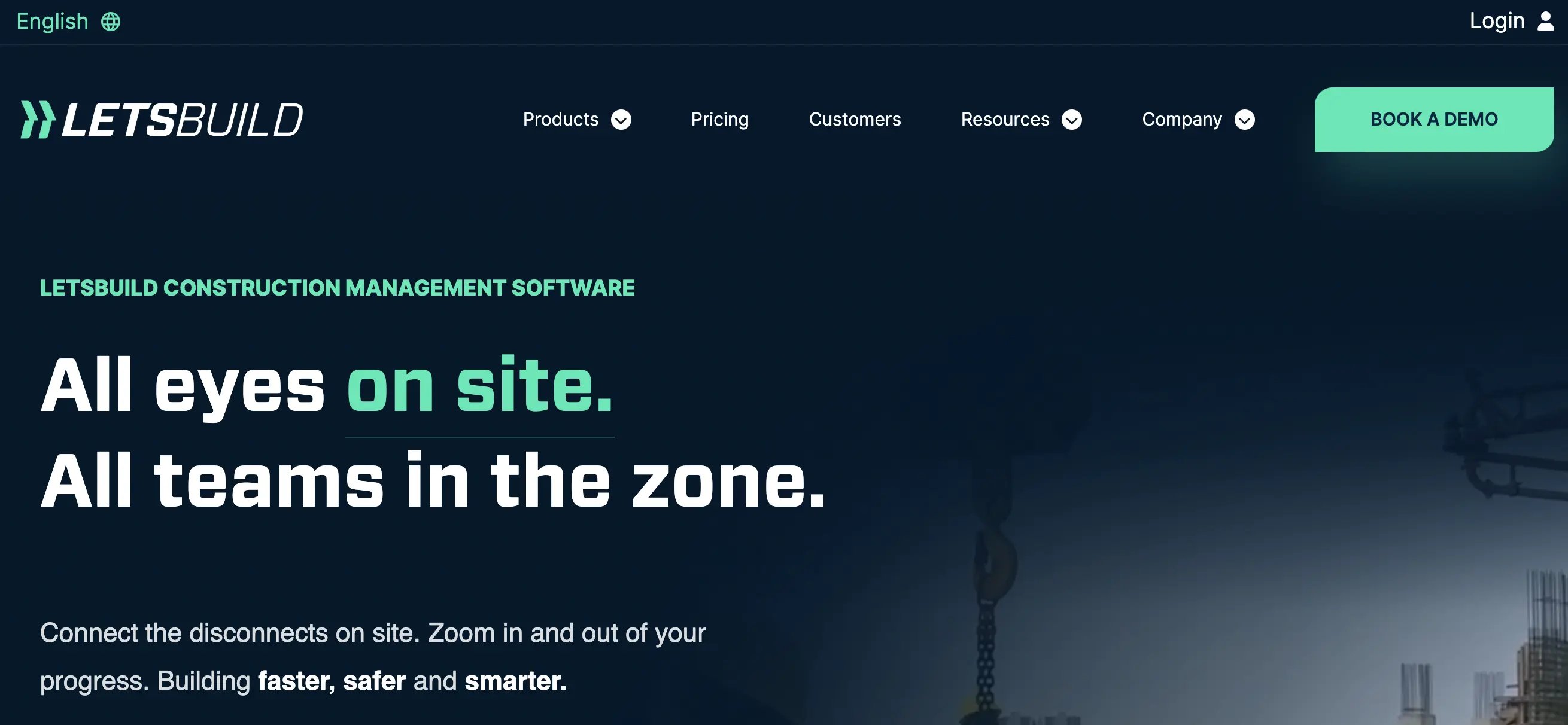
LetsBuild is a cloud-based construction project management software designed to provide real-time visibility and control across large-scale civil, commercial, and residential projects. Catering to executives, onsite managers, and foremen, it offers a comprehensive toolset for planning, managing workflow, ensuring quality, and sharing project information.
Letsbuild key features:
Letsbuild has three features:
- LB Aproplan: Streamlines defect management, handovers, and QHSE checklists with automated data input and report generation.
- LB Geniebelt: Enables real-time collaboration and progress tracking, preventing double bookings and missed deadlines.
- LB Maintenance: Facilitates inspection data collection, scheduling, reporting, and compliance management.
Letsbuild pros:
- Comprehensive toolset for end-to-end project management
- Real-time task management and communication
- Powerful features designed for large-scale projects
Letsbuild limitation:
- Can be time-consuming to learn and set up
- May be expensive for smaller businesses
- Most user reviews are outdated, limiting recent feedback
- No transparent pricing
Letsbuild pricing:
Pricing is unavailable on their website.
Our take on each tool:
Buildbite is perfect for small to medium-sized contractors and specialized trades who want a simple, mobile-first solution that keeps teams connected and projects moving without complexity or high cost.
Buildertrend suits residential builders and specialty contractors who need a comprehensive platform combining project management with sales and client relationship tools.
Admicom targets large construction firms requiring detailed lifecycle management and financial control, especially for complex projects.
Fieldwire excels for teams focused on jobsite coordination and field task management, particularly on large or complex projects needing BIM integration.
Procore is best for large commercial developers and contractors managing multi-million-dollar projects who need a robust, integrated platform with extensive features and strong support.
Letsbuild fits large-scale facility management teams and companies looking for real-time collaboration and quality assurance tools but may be less accessible for smaller firms due to pricing and setup complexity.
Comparison of the top 6 real estate development tools
|
Software |
Target Business Size |
Core Strength |
Standout Feature |
Ease of Use |
Integration Score |
Pricing Model |
|
Buildbite |
Small to Medium |
Job Management |
Mobile-first, real-time task & time tracking |
Very User-Friendly, Fast Onboarding |
Good (basic integrations) |
Tiered (Basic $90/mo to Premium $205/mo) |
|
Buildertrend |
Small to Medium |
All-in-One (PM + Sales) |
Sales management with CRM and client portal |
Moderate (Steep learning curve) |
Moderate (some integrations) |
Tiered ($499 to $1,099/mo) |
|
Admicom |
Large |
Construction Lifecycle |
Cost and quantity management with real-time order monitoring |
Moderate (some bugs reported by users) |
Strong financial integrations |
Quote-based (not public) |
|
Fieldwire |
Medium to Large |
Job Site Management |
Comprehensive field task management and BIM viewer |
User-Friendly, Quick Setup |
Moderate (limited integrations) |
Per user ($39 - $79/user/mo) |
|
Procore |
Large |
All-in-One (Enterprise) |
End-to-end project and financial management with strong integrations |
Moderate to Difficult (Steep learning curve) |
Excellent (many integrations) |
Quote-based (starts ~$375/mo) |
|
Letsbuild |
Large |
Facility & Project Management |
Real-time collaboration and defect management |
Moderate (Time-consuming setup) |
Limited (not transparent) |
Quote-based (not public) |
Types of real estate development software
Project management-centric platforms
These platforms focus on organizing and coordinating all phases of a development project. They centralize communication among stakeholders, track schedules, manage tasks, and handle documentation. If you frequently deal with tight timelines, multiple contractors, and shifting site conditions, this type of software can help keep everyone aligned and your project on track.
Financial and proforma-focused tools
Designed primarily for financial modeling and investment analysis, this software helps developers create detailed proforma statements, forecast cash flows, and evaluate different investment scenarios. If your biggest challenge lies in managing cash flow, assessing project viability, or attracting investors, this type of tool can provide the financial clarity you need.
All-in-one platforms
All-in-one solutions combine project management, financials, reporting, and collaboration tools into a single platform. While they may require a larger investment upfront, they’re ideal for businesses looking to reduce tool sprawl and centralize their workflows. These platforms often include customizable dashboards, integration options, and support for cross-functional teams.
Specialized software
These tools focus on niche areas within real estate development, like land acquisition, site evaluation, environmental compliance, or BIM (Building Information Modeling) integration. They often fill gaps that broader platforms don’t cover and can be used alongside other tools for a more tailored tech stack.
What is the best software for real estate management?
Since real estate management covers everything from property development to asset management, and investment & financing, there is no one-size-fits-all tool. The best software for real estate management depends on the specific needs of your business, such as property type, portfolio size, and the level of functionality required. If you run a real estate development firm and need a tool to handle client interactions, coordinate with contractors, and oversee multiple developments all in one place, Buildbite is the right software for you.
How to choose the right real estate development software: The 5 key questions
The right real estate development software is one that simplifies how you manage the design, planning, construction, or remodeling of properties. To make the best choice, consider these five key questions:
- Can I remotely collaborate with on-site teams, office staff, subcontractors, and clients without relying on cumbersome emails and messenger apps?
The ideal software should provide centralized, real-time collaboration tools, such as shared task boards, instant messaging, document sharing, and client portals, that reduce email overload and prevent lost or delayed information. This ensures everyone stays aligned, minimizes misunderstandings, and accelerates decision-making across team members dispersed across sites and offices.
- Does the software allow me to assign, track, and manage tasks efficiently across multiple real estate developments?
Opt in for a software that supports detailed task scheduling, progress tracking, and deadline management. Look for features like phase breakdowns, role-based permissions, automated reminders, and mobile accessibility, so project managers and field teams can update reports on the go. This level of control provides real-time visibility into project milestones and keeps everything on schedule.
- Can I create accurate cost estimates for materials, labor, and other project expenses to stay within budget?
Budget overruns are a common challenge in real estate development, especially for large-scale projects. Your software can include budgeting and cost estimation tools that factor in all expenses: materials, labor, permits, subcontractors, and overhead. It should allow you to compare actual costs against estimates and flag variances early before costs spiral out of control.
- Is it possible to generate invoices automatically based on completed work, tracked time, or milestones achieved?
Automating invoicing reduces administrative burden and speeds up cash flow. A software that links task completion and time tracking directly to billing functions enables you to generate accurate invoices without manual data entry.
- Can I produce detailed financial reports that help assess profitability, identify cost overruns, and make informed decisions?
Accurate, customizable reporting is crucial for tracking project health and making data-driven decisions. If this is a key feature for your team, look for tools that offer in-depth financial reports covering budget vs. actuals, cash flow, resource allocation, and profitability by project or portfolio.
Key features to look for in a modern real estate development software
Cloud-based accessibility and mobile apps
Cloud deployment ensures your project data is accessible anytime, from any device. Mobile apps empower real estate developers, project managers, contractors, and field workers to update tasks, submit reports, and communicate seamlessly. This flexibility keeps all stakeholders connected regardless of location.
Real-time collaboration and communication tools
Real estate development projects require seamless coordination among developers, architects, contractors, and clients. Features like live document editing, instant messaging, video conferencing, and centralized communication reduce miscommunication and accelerating decision-making.
Robust project scheduling and tracking
Tools such as Gantt charts, calendars, and milestone tracking help break down complex projects into manageable phases and tasks. Assigning responsibilities, setting deadlines, and monitoring progress in one place prevents bottlenecks and keeps projects running smoothly.
Budgeting, cost control, and financial reporting
Accurate budgeting and expense tracking are necessary to avoid costly overruns. Modern software provides real-time budget monitoring, alerts for overspending, and detailed cost breakdowns for materials, labor, and subcontractors.
Document management and version control
Projects generate a high volume of documentation: blueprints, permits, contracts, RFIs. A centralized document system ensures that everyone is working off the latest version, with permission controls and audit trails to reduce errors, duplications, and legal risks.
Task management and workflow automation
Modern tools should streamline task creation, assignment, and progress tracking. Bonus points if it supports automation, for example, auto-assigning tasks, sending status updates, or notifying stakeholders when approvals are needed. This reduces manual work and speeds up execution.
Reporting and analytics dashboards
Analytics empower project managers and executives to make data-driven decisions, identify trends, and optimize future developments. Live reporting also improves transparency with stakeholders and clients.
Integration with other business systems
Seamless integration with other tools, e.g. customer relationship management (CRM) tools, and accounting tools prevents data silos and duplication. This connectivity streamlines workflows across departments, from sales and finance to construction and maintenance, improving overall operational efficiency.
AI-powered insights / Automation
Advanced platforms are beginning to offer AI features that analyze historical project data to predict risks, optimize schedules, or suggest cost-saving opportunities. This proactive approach helps teams make strategic decisions.
How to ensure the implementation and adoption of the software
Brief tips for a successful software rollout
Plan thoroughly before launch: Assess your business needs and pain points to select software that truly fits your workflows. Customize the software to align with your processes and consider a phased rollout, starting with key features to allow gradual adaptation and minimize disruption.
Engage key stakeholders early: Involve project managers, on-site teams, office staff, and clients during implementation planning. Their input helps tailor the software and fosters a sense of ownership, reducing resistance to change.
Provide comprehensive training: Invest in hands-on training sessions tailored to different user roles. Use tutorials, workshops, and ongoing support to build confidence and competence. Training accelerates adoption and reduces errors.
Encourage open communication and feedback: Create channels for users to report challenges and suggest improvements. Regularly gather feedback to identify issues early and make necessary adjustments, turning obstacles into opportunities for refinement.
Monitor progress and performance: Define clear key performance indicators (KPIs) such as task completion rates, budget adherence, and user engagement. Use these metrics to evaluate whether the software improves efficiency and project outcomes.
Importance of team training and buy-in
The best software is only as effective as the people using it. Team buy-in is crucial because it:
Reduces resistance: When users understand the benefits and feel involved, they are more likely to embrace the change rather than resist it.
Improves productivity: Well-trained staff can leverage software features fully, reducing errors and accelerating workflows.
Improves collaboration: Training ensures everyone uses the same tools consistently, improving communication and coordination across teams.
Supports continuous improvement: Engaged users provide valuable insights that help optimize software use and drive ongoing enhancements.
How to measure if the software is delivering value
To determine if your real estate development software is meeting expectations, track these indicators:
Operational efficiency: Are projects completing on time with fewer delays? Is task management smoother?
Financial performance: Are budgets more accurate? Have cost overruns decreased? Are invoices generated faster and with fewer errors?
User adoption and satisfaction: Are team members actively using the software? Do they report that it simplifies their work?
Communication effectiveness: Has the volume of miscommunication or missed updates declined? Are stakeholders better informed in real time?
Return on investment (ROI): Compare the software’s cost against measurable improvements in project delivery, client satisfaction, and administrative savings.
Looking for more help? Download our free resources below to support your work.
Download free real estate development software resources
As you explore your options for real estate development software, having the right resources at your fingertips can make all the difference. To help, we've curated a collection of templates and guides to support your decision-making process.
- The Ultimate Pre Construction Checklist For Building Contractors: Use this checklist to ensure your schedules, cost estimates, project teams and clients are all aligned before work commences on site.
- Construction Cost Estimate Template: Download our free construction cost estimate template for precise budgeting and effective project management.
- Construction Punchlist: A Template and Checklist: Download this free construction punchlist template for professional contractors to easily keep track of your outstanding tasks.
- The Ultimate RFI Construction Template: Use this editable RFI template to efficiently communicate and exchange information in your construction projects.
Conclusion
Finding the right real estate development software isn’t just about checking off a list of features. It’s about choosing a tool that fits your team, supports your workflows, and helps you complete projects on time and within budget.
In this guide, we’ve covered everything you need to make a confident decision: from understanding your project needs to evaluating top-rated tools side-by-side. Whether you’re a small-scale real estate developer or a growing team looking for better coordination, you'll find a solution out there built for your needs.
Ready to see the difference the right software can make? Try Buildbite free for 14 days and experience streamlined communication, field visibility, and real-time progress tracking suited specifically to small to mid-sized real estate teams.
FAQ
What is real estate development software, and why does it matter?
Real estate development software is a specialized tool that helps developers manage every stage of a project, from early planning and budgeting to construction and final delivery. It combines features like budgeting, scheduling, document sharing, and team communication into a single platform for smoother project workflows.
While spreadsheets, emails, and file-sharing platforms are helpful, they aren’t designed for complex development projects. Relying on them often leads to project delays, budget overruns, scattered communication, and inefficient workflows. Over time, these setbacks can have a serious impact on your profits. However, real estate development software helps address these challenges.
What is the average cost of real estate development software?
The average cost of real estate development software ranges from $50 to $300 per user per month for cloud-based solutions, with enterprise-level platforms charging upwards of $1,000/month or more based on project size, features, and support levels or requiring custom quotes.
Can small developers benefit from this software?
Yes, small developers and contractors can gain value from real estate development software. Affordable, user-friendly options like Buildbite offer mobile-first, real-time job management that improves communication, task tracking, and budgeting without high costs or complexity.
How long does it take to implement real estate development software?
Implementation usually takes from a few weeks to several months depending on the software complexity, customization needs, and team readiness. While user-friendly tools like Buildbite can be adopted quickly, a phased rollout with training is necessary for the proper adoption of more complex software.
What's the difference between real estate CRM and development software?
Real estate CRM focuses on managing leads, client relationships, and sales pipelines, while development software manages project planning, budgeting, construction workflows, and collaboration throughout the property development lifecycle.
How does real estate development software help with risk management?
It helps identify and mitigate risks by providing real-time budget tracking, deadline monitoring, document control, and compliance management. Also, early alerts on cost overruns or schedule delays enable proactive decision-making, which can reduce financial and operational risks.




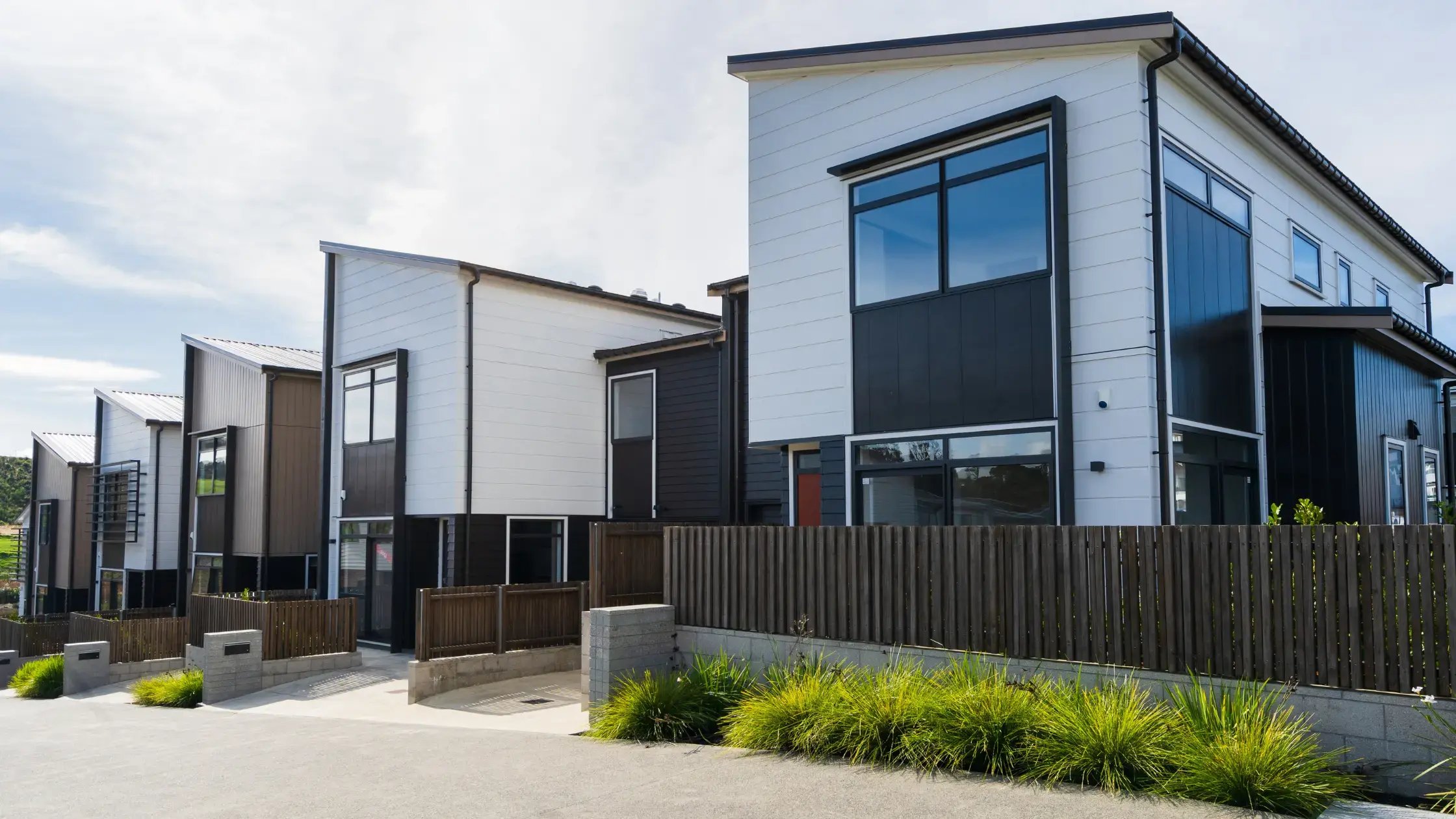
%20(2)%20(1).webp?width=7617&height=3410&name=buildbite.com_(High%20res)%20(2)%20(1).webp)




